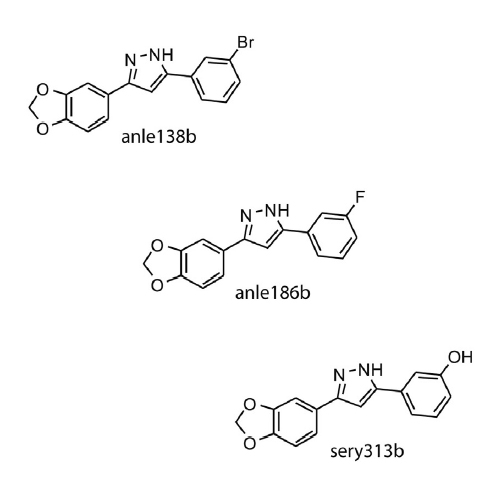Anle138b and related compounds are aggregation specific fluorescence markers and reveal high affinity binding to α-synuclein aggregates
29-May-2015
Biochimica et Biophysica Acta, 2015, doi:10.1016/j.bbagen.2015.05.021, Volume 1850, Issue 9, Pages 1884–1890 published on 29.05.2015
Biochimica et Biophysica Acta, online article
Biochimica et Biophysica Acta, online article
Background: Special diphenyl-pyrazole compounds and in particular anle138b were found to reduce the progression of prion and Parkinson's disease in animal models. The therapeutic impact of these compounds was attributed to the modulation of α-synuclein and prion-protein aggregation related to these diseases. Methods: Photophysical and photochemical properties of the diphenyl-pyrazole compounds anle138b, anle186b and sery313b and their interaction with monomeric and aggregated α-synuclein were studied by fluorescence techniques. Results: The fluorescence emission of diphenyl-pyrazole is strongly increased upon incubation with α-synuclein fibrils, while no change in fluorescence emission is found when brought in contact with monomeric α-synuclein. This points to a distinct interaction between diphenyl-pyrazole and the fibrillar structure with a high binding affinity (Kd = 190 ± 120 nM) for anle138b. Several α-synuclein proteins form a hydrophobic binding pocket for the diphenyl-pyrazole compound. A UV-induced dehalogenation reaction was observed for anle138b which is modulated by the hydrophobic environment of the fibrils. Conclusion: Fluorescence of the investigated diphenyl-pyrazole compounds strongly increases upon binding to fibrillar α-synuclein structures. Binding at high affinity occurs to hydrophobic pockets in the fibrils. General significance: The observed particular fluorescence properties of the diphenyl-pyrazole molecules open new possibilities for the investigation of the mode of action of these compounds in neurodegenerative diseases. The high binding affinity to aggregates and the strong increase in fluorescence upon binding make the compounds promising fluorescence markers for the analysis of aggregation-dependent epitopes.











